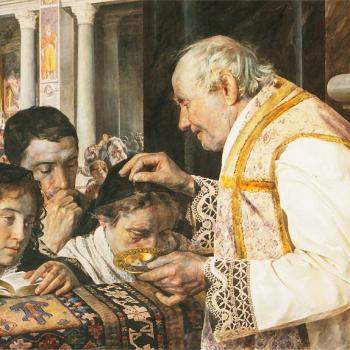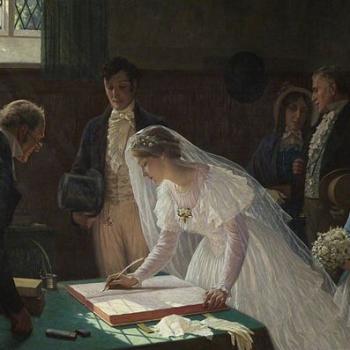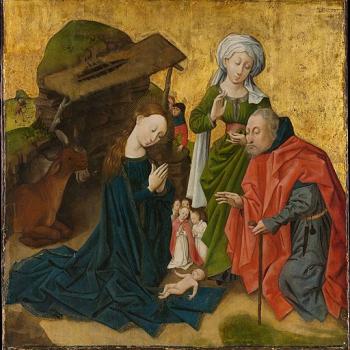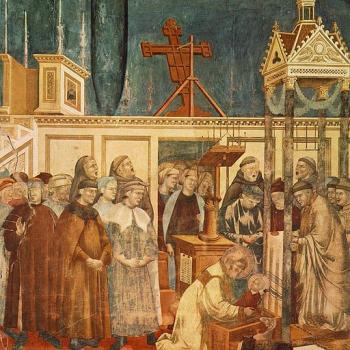This post is the continuation of my ruminations on Pacem in Terris from my Catholic social teaching reading group. The first part can be found here.
For this meeting we read the second section of PT, paragraphs 46-79, on the relationship between the state and the individual. This is a shorter but interesting statement. In line with the previous documents, John XXIII takes the existence and need for the state as something given by the natural law:
Human society can be neither well-ordered nor prosperous without the presence of those who, invested with legal authority, preserve its institutions and do all that is necessary to sponsor actively the interests of all its members. (par. 46)
This would seem to rule out any notion of Christian anarchism–an idea I have been interested in since first reading about Dorothy Day and the Catholic Worker movement over 20 years ago. This is not an idea I want to spend any time on, though it seems that there should be room for dialog between this traditional Catholic understanding of the state and the anarchist rejection of it. As we will discuss below, this encyclical constrains the power of the state in ways which leave room for discussion about how legal authority (which must exist in some form in any large anarchist community) is exercised and whether that is consonant with anarchist ideas. (Note, here I am referring to a proper political philosophy and not to the stereotype of demonstrators in black trashing Starbucks or clashing with white supremacists. In particular, I am grateful to the late Murray Bookchin, who ended up repudiating the label anarchist, for his searing critique of what he dubbed lifestyle anarchism.)
Our discussion did, however, immediately start with a discussion of the authority of the state. Paragraph 46 above continues with a quote from St. Paul that “there is no power but from God.” ( Referencing Romans 13:1-6.) The immediate critique of this position is that this would seem to include bad as well as good rulers: or, as I have heard it said, “Does this mean that Iraqis were bound by God to obey Saddam Hussein?” Paragraph 47 starts with an immediate rejoinder to this argument from St. John Chrysostom:
What are you saying? Is every ruler appointed by God? No, that is not what I mean, he says, for I am not now talking about individual rulers, but about authority as such. My contention is that the existence of a ruling authority—the fact that some should command and others obey, and that all things not come about as the result of blind chance—this is a provision of divine wisdom. (par. 47)
The argument seems to be that the very nature of state authority is such that, if it is exercised in conformity with natural and divine law, then it derives its authority from God. Any ruler, good or bad, can only claim divine authority for laws and actions which meet this test; if they do not, then they are not ruling with the authority of God, but only by force. This aligns with what Jesus said to Pilate (see John 19:11): his authority as Roman governor came from above–its proximate source was the Roman Empire, but ultimately, any ruling authority comes from God. Pilate is able to act unjustly, not because he is doing God’s will, but because he has the (military) power of the Empire at his disposal. In passing, one member of our group noted that this model of governance does not seem to address the reality of evil in the world; this really seems to be the case but we did not pursue this question further.
This leads to a grounding of governmental authority in the conscience of the individual, rather than in the power of the state:
a regime which governs solely or mainly by means of threats and intimidation or promises of reward, provides men with no effective incentive to work for the common good. And even if it did, it would certainly be offensive to the dignity of free and rational human beings. Authority is before all else a moral force. (par. 48, emphasis added.)
One member of the our group, who was a conscientious objector during the Vietnam war, saw a clear connection between this paragraph and the concept of conscientious objection. The state literally has no right to force anyone to act in contravention to divine or natural law. The encyclical makes this clear:
Governmental authority, therefore, is a postulate of the moral order and derives from God. Consequently, laws and decrees passed in contravention of the moral order, and hence of the divine will, can have no binding force in conscience, since it is right to obey God rather than men. (par. 51)
I would note in passing that the Church was a long time in accepting the right of conscientious objection: a quick summary is given by this Pax Christi pamphlet (pdf file). As it notes, Church teaching began to change after WW II; I would suspect that it was language like this in this encyclical which gave impetus to this change. In passing, I would note that when looking for this material, I stumbled upon the other usage of the term: the right of doctors and nurses to refuse to perform abortion, prescribe contraceptives, and otherwise engage in actions contrary to Church teaching. This is often cast as a religious liberty argument, but it strikes me now that it may be in some sense more fundamental, as it touches on the very relation between the state and the individual. (This question is made more complicated by what an employer who is not the state may be compel its employees to do. The only firm opinion I have on this is that it is complicated.)
Another member of our group noticed an interesting coincidence in timing. This encyclical was published on April 11, 1963, Holy Thursday. The next day, Good Friday, Martin Luther King Jr. was arrested in Birmingham; on April 16, Easter Tuesday, he released the now famous Letter Birmingham Jail. This letter is a challenge to the authority of the state when it is used to oppress and marginalize individuals (in this case African-Americans). His argument seems to share many points in common with the PT; it would be worthwhile to examine the letter in light of this encyclical.
Our discussion then turned to the purpose of the state, which the encyclical makes clear:
The attainment of the common good is the sole reason for the existence of civil authorities. In working for the common good, therefore, the authorities must obviously respect its nature, and at the same time adjust their legislation to meet the requirements of the given situation. (par. 54)
The encyclical then goes on to expound on what the common good is. From the discussion, it is clear that the “good” State, in the mind of John XXIII, has more in common with the social welfare states of Western Europe than any model of limited government popular in conservative and libertarian circles. The state must uphold the rights of individuals, including the social and economic rights enumerated earlier in the document. These are spelled out in careful detail which it is worth quoting in full to drive home (to an American audience) what the Church teaches is the responsibility of government:
The public administration must therefore give considerable care and thought to the question of social as well as economic progress, and to the development of essential services in keeping with the expansion of the productive system. Such services include road-building, transportation, communications, drinking-water, housing, medical care, ample facilities for the practice of religion, and aids to recreation. The government must also see to the provision of insurance facilities, to obviate any likelihood of a citizen’s being unable to maintain a decent standard of living in the event of some misfortune, or greatly in creased family responsibilities.
The government is also required to show no less energy and efficiency in the matter of providing opportunities for suitable employment, graded to the capacity of the workers. It must make sure that working men are paid a just and equitable wage, and are allowed a sense of responsibility in the industrial concerns for which they work. It must facilitate the formation of intermediate groups, so that the social life of the people may become more fruitful and less constrained. And finally, it must ensure that everyone has the means and opportunity of sharing as far as possible in cultural benefits. (par. 64)
We spent some time trying to determine what “ample facilities for the practice of religion” entailed–did this mean the state was to build churches? Consulting the Spanish and French translations, it seems more likely that this refers to a more general obligation to create conditions that promote the free practice of religion. This is certainly consonant with the earlier injunction that the state
must respect the hierarchy of values, and aim at achieving the spiritual as well as the material prosperity of their subjects. (par. 57)
Given the emphasis on the rights of individual conscience, this cannot be interpreted as any kind of Catholic integralism or Catholic fascism (which Pius XI seemed to toy with in QA), but rather as creating the space for individuals to seek spiritual ends.
In the end, this section really becomes a full-throated defense of constitutional democracy, the separation of powers, and also, rightly understood, the separation of Church and State. Paragraph 67 cautions that “it is not possible to give a general ruling on the most suitable form of government“, so at least in principle the Church does not commit itself to a single political system or vision of government. But, in reflecting on the then current situation, the subsequent paragraphs (68-72) lays out principles of governance that sound very much like parliamentary or US constitutional democracy.
This led to an interesting discussion, since, as I noted in my previous post, it seems quite hard to reconcile this with earlier Catholic teaching, particularly Pius IX and the Syllabus of Errors, which seemed to be pretty firm in its rejection of liberal democracy. Clearly, WW II and in particular the reflections of Pius XII on the war (who never wrote an encyclical on this subject but gave several long radio addresses that were extensively quoted in Mater et Magistra) played a major role. But the matter of reconciling the old and the new remains. One member of our group argued for a hermeneutic of continuity, arguing that these ideas were implicit in earlier Catholic teaching, particularly St. Thomas Aquinas; a different aspect of Catholic teaching had been emphasized through the Reformation and into the 19th century; and that finally a deeper examination brought to light these older ideas and led to their fuller development.
I must confess that I am not fully convinced by this line of argument as it has always struck me as a post facto explanation designed to show that the Church can never be wrong or go down a blind alley in the development of doctrine. As an alternative, I made passing mention of an idea from continental philosophy which may be useful in explaining these changes, though I have never seen it applied specifically to the evolution of Catholic doctrine, that of an event. An event is something that happens that has no good explanation in terms of casuality from what happened previously, and whose occurrence changes how we think about what came before. Zizek gives the example of falling in love. We cannot really explain why we fell in love, and our understanding and appreciation of the person we love changes after this event. In politics and history, certain events are thought to have been equally cataclysmic in the way they changed our perceptions. When I first read about the event, a colleague suggested the model of the French Revolution and the divine right of kings: before revolution, absolute monarchy was a generally accepted concept. After the revolution (and its aftermath), absolute monarchs were regarded as despots–the very understanding of government had changed.
Though not a historian, I am inclined to think that the case can be made that the Reformation was an event: how the Church saw itself in the Middle Ages and how it saw itself in post-Reformation period, and how it interpreted how it had previously understood itself in the Middle Ages, were very different: the Medieval Church we see today is seen through the lens of the Reformation. So the question for me is this: was Vatican II, or more precisely, the dramatic evolution of Catholic thought in the post WW II period, an event? Did our very understanding of ourselves change so dramatically that in fact we could now find in Thomas Aquinas and other earlier sources a justification for liberal democracy which, 30 years previously, Catholic thinkers simply did not (and perhaps could not) see? I am not sure if it is or not, but if it was, this would give us a way of understanding the changes that have rocked the Church in the 20th century.












